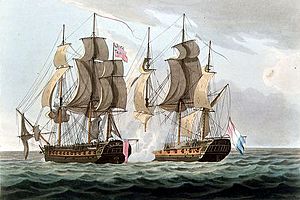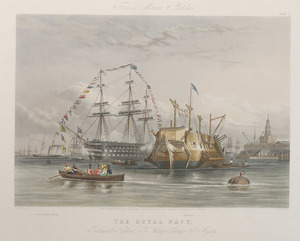HMS Dryad (1795) facts for kids

HMS Dryad taking the French frigate Proserpine as a prize, 13 June 1796, by Thomas Whitcombe
|
|
Quick facts for kids History |
|
|---|---|
| Name | HMS Dryad |
| Ordered | 24 May 1794 |
| Builder | William Barnard, Deptford |
| Laid down | June 1794 |
| Launched | 4 June 1795 |
| Decommissioned | 13 September 1832 |
| Out of service | 1814 - 1827 |
| Honours and awards |
Naval General Service Medal (NGSM) with clasp "Dryad 13 June 1796" |
| Fate |
|
| General characteristics | |
| Class and type | 36-gun fifth-rate frigate |
| Tons burthen | 9246⁄94 (bm) |
| Length |
|
| Beam | 38 ft 2+1⁄2 in (11.6 m) |
| Depth of hold | 13 ft 5 in (4.1 m) |
| Sail plan | Ship rigged |
| Complement | 264 |
| Armament |
|
HMS Dryad was a fast sailing ship called a frigate in the Royal Navy. She served for 64 years, first during the Napoleonic Wars and later helping to stop the slave trade. One of her most famous moments was in 1796 when she captured a French frigate named Proserpine. This brave action earned her crew a special medal. Dryad was eventually taken apart in 1860.
Contents
Building and Early Days (1795)
Dryad was built by William Barnard in Deptford and launched on June 4, 1795. She was a "fifth-rate" frigate, meaning she was a medium-sized warship with many guns. Her first captain was Robert Allaster Cam Forbes. Sadly, Captain Forbes drowned off the coast of Norway just a few months after taking command.
Capturing the French Frigate Proserpine (1796)
After Captain Forbes, Lord Amelius Beauclerk took command of Dryad in December 1795. Dryad was stationed near Ireland. On June 13, 1796, Dryad spotted the French frigate Proserpine. The French ship tried to escape, but Dryad chased her for hours.
At 9 p.m., Dryad caught up and a fierce battle began. For 45 minutes, the two ships fired their cannons at each other. Dryad fought bravely and forced Proserpine to surrender. The French ship had 30 sailors killed and 45 wounded. Dryad had only two killed and seven wounded.
The Royal Navy took Proserpine as a prize and renamed her Amelia. Years later, in 1847, the surviving crew members of Dryad received the Naval General Service Medal for their courage in this battle.
Chasing Privateers (1796-1798)
After her big victory, Dryad continued to patrol the seas. She captured or destroyed several French privateers. Privateers were private ships allowed by their government to attack enemy merchant ships.
- On October 16, 1796, she captured the French privateer Vantour.
- In August 1797, she captured another privateer called Éclair.
- On September 9, 1797, Dryad sank the 12-gun French privateer Cornélie.
- In October 1797, Dryad and another British ship, Doris, captured the French privateer Brune.
- Finally, on February 4, 1798, Dryad captured the 16-gun privateer Mars.
Serving in Ireland (1799-1801)
In December 1798, Captain Charles John Moore Mansfield became the new commander of Dryad. His wife and two children sometimes lived on board, which was unusual! His wife even wore her own version of a naval uniform.
Dryad was based in Cork, Ireland, for several months in 1800. She helped escort convoys of ships, including some carrying prisoners to Australia. She also helped another British frigate, Revolutionnaire, which had lost its rudder in a hurricane. Both ships had a tough time getting back to port.
Capturing Premier Consul (1801)
On March 5, 1801, west of Ireland, Dryad chased and captured the French privateer Premier Consul. This ship was armed with 14 guns and had 150 men. Dryad also captured a Swedish frigate, HMS Ulla Fersen, after a short fight. The British Navy later returned Ulla Fersen to Sweden.
Peace and Return to Duty (1802-1804)
After a peace treaty was signed in 1802, Dryad returned to Portsmouth. She was used to stop smuggling near Portland. But the peace didn't last long, and war with France started again in May 1803.
Battles and Missions During the Napoleonic Wars
Spotting French Ships (1805)
In 1804, Captain Adam Drummond took command of Dryad. In November 1805, Dryad and another British ship, Boadicea, spotted four French warships that had escaped from the famous Battle of Trafalgar. Dryad and Boadicea tried to lead the French ships towards a larger British fleet. Even though they lost sight of the French ships, their signals helped another British squadron find and capture all four French warships in the Battle of Cape Ortegal.
Fighting Slave Ships (1830-1832)
After some time out of service, Dryad was recommissioned in 1825 for duty in the Mediterranean Sea. Later, from 1830 to 1832, Dryad played a very important role in the West Africa Squadron. This squadron worked hard to stop the illegal slave trade.
Captain John Hayes commanded Dryad during this time. Dryad had two smaller ships, Fair Rosamond and Black Joke, which were actually captured slave ships themselves. These smaller ships, working with Dryad, captured 11 out of 13 slave ships caught by the squadron during this period.
Life on the West Africa station was tough due to disease, but visits to Ascension Island gave the crew a break and fresh supplies. Dryad also helped map the seas, making them safer for other ships.
End of Service
Dryad returned to Portsmouth in July 1832 and was taken out of service for the last time on September 13, 1832. She then became a "receiving ship" at Portsmouth, which meant she was used as a floating base or barracks. After a long and active life, HMS Dryad was finally taken apart in 1862.
Commanding Officers
Here are the captains who commanded HMS Dryad during her service:
| From | To | Captain |
|---|---|---|
| June 1795 | October 1795 | Captain Hon. Robert Forbes |
| December 1795 | December 1798 | Captain Lord Amelius Beauclerk |
| February 1799 | June 1802 | Captain Charles John Moore Mansfield |
| May 1803 | February 1804 | Captain Robert Williams |
| 1804 | 1804 | Captain John Giffard |
| 1804 | 1809 | Captain Adam Drummond |
| July 1807 | 1808 | Captain William Price Cumby (temporary) |
| 1809 | 1814 | Captain Edward Galway |
| August 1825 | July 1826 | Captain The Hon. Robert Rodney |
| July 1826 | 1830 | Captain The Hon. George Alfred Crofton |
| May 1830 | September 1832 | Captain John Hayes |
Images for kids




